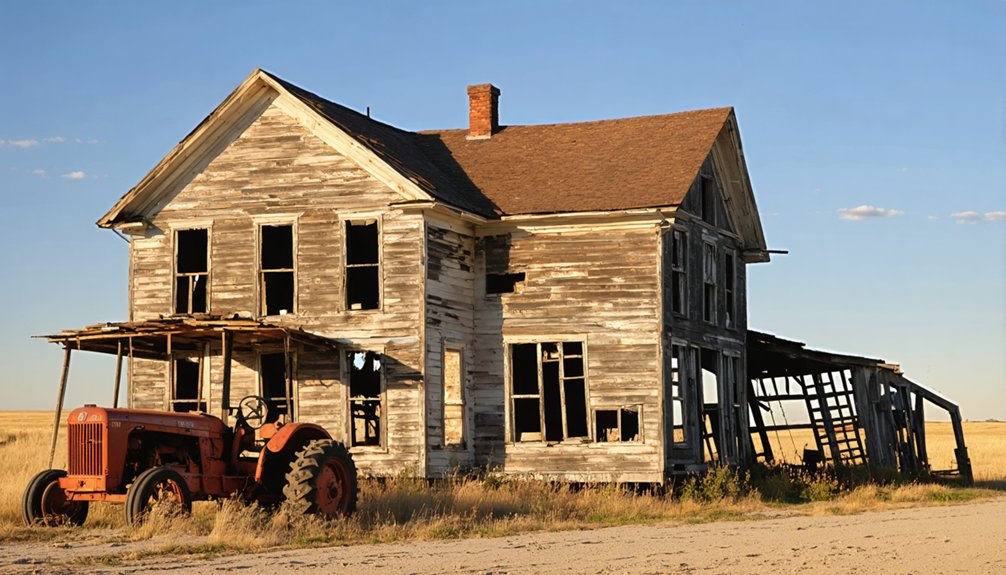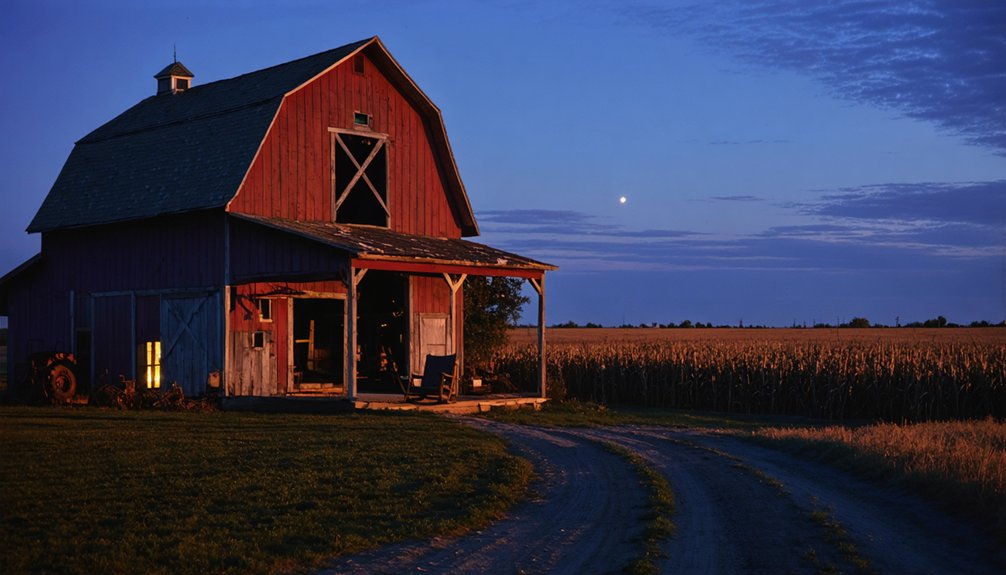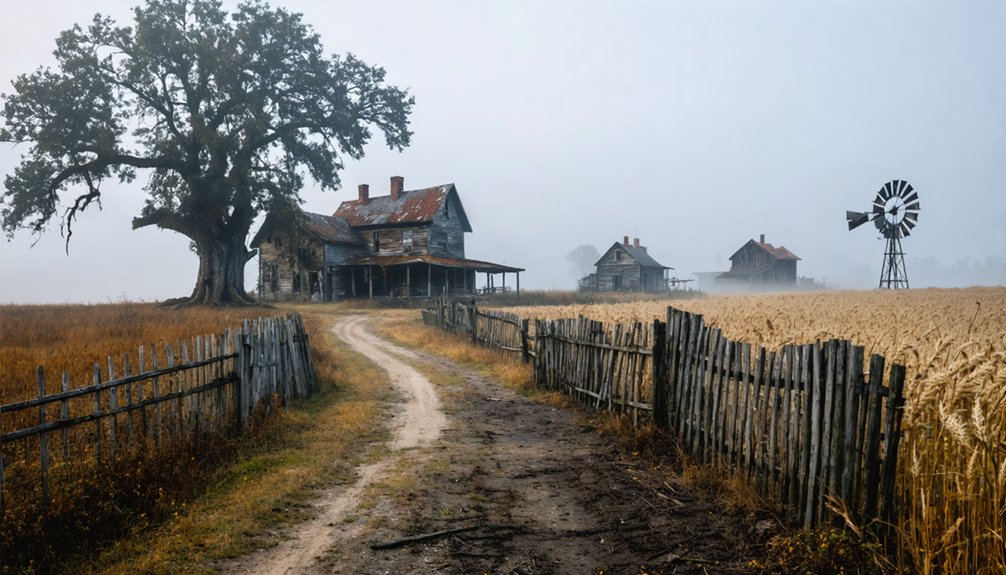You’ll find America’s abandoned farm communities scattered across the Great Plains, Mississippi Delta, and river valleys—silent witnesses to broken dreams. These ghost towns emerged from the 1862 Homestead Act, only to succumb to drought, floods, and economic hardship. Collapsed barns, empty schoolhouses, and forgotten African-American settlements like Dearfield tell stories of resilience and defeat. These eerie landscapes now offer more than just haunting beauty.
Key Takeaways
- Thousands of ghost towns across the Great Plains were established during wetter periods but later abandoned due to harsh environmental conditions.
- Dearfield, Colorado was once a thriving African-American farming community before collapsing from water scarcity in the 1930s.
- Mississippi River Valley contains numerous abandoned homes and farmsteads reclaimed by floodwaters and erosion over decades.
- Over 30 million acres of former cropland now lie dormant across the country, reverting to wild landscapes after agricultural abandonment.
- Rusted farm equipment, collapsed cotton gins, and decaying farmhouses create eerie sculptures across rural American landscapes.
Ghost Towns of the Great Plains: Where Water Once Flowed

Thousands of forgotten communities dot the Great Plains landscape, silent monuments to America’s complex relationship with the land.
You’re looking at the remnants of hope and heartbreak—settlements born during wetter periods when the soil promised prosperity. The Homestead Act of 1862 released a wave of settlers who built lives on this unforgiving terrain, establishing ghost towns that would later succumb to nature’s harsh realities.
These agricultural history markers tell a story of boom-and-bust cycles, where families staked everything on uncertain rainfall patterns. Among these was Dearfield, Colorado, once a thriving African-American community that collapsed when water scarcity devastated crops during the 1930s.
When the prairies whispered promises, families listened—planting futures on land that gave and took with equal measure.
When you explore these abandoned places, you’re walking through living documents of American resilience and failure. Nicodemus remains the only surviving Black homesteading settlement from this era, with a current population of just 20 residents. By the 1930s, the devastating Dust Bowl sealed the fate of many struggling communities, forcing families to abandon homes and dreams in search of survival elsewhere.
Mississippi River Valley’s Forgotten Farmsteads
You’ll find ghostly remnants of once-thriving plantations scattered across the Mississippi Delta, where millions of acres were abandoned after the Civil War and later reclaimed by the state.
The Great Flood of 1927 forced countless families to evacuate their farms and homesteads, creating a mass displacement that tore communities apart and left waterlogged lands behind. Some families dismantled their homes piece by piece to relocate across the Mississippi River, while others left the state entirely.
If you walk these forgotten grounds today, you’ll spot the weathered foundations of old farmhouses, subsidence homesteads, and collapsed barns—silent witnesses to the region’s complex history of agricultural boom and bust. Near Jackson, Mississippi, there’s even an abandoned 200-acre site where Army Corps engineers once built massive river models to test flood prevention measures.
Ghost Towns Dot Landscape
Shadows of forgotten lives linger along the Mississippi River Valley, where ghost towns now dot the landscape like fading memories on an old photograph.
You’ll find abandoned homes nestled behind levees—derelict farmhouses and fallen sharecropper shacks swallowed by vegetation, telling forgotten histories of river-edge refugees who sought shelter from storms and economic ruin.
These ghost towns—once vibrant communities of river gypsies, displaced families, and frontiersmen—reached their peak during the Great Depression when tens of thousands inhabited stilt houses and shanties.
The haunting remnants of plantations reveal where enslaved people once lived in cramped two-room cabins, now mostly vanished through neglect or demolition. Archaeological evidence from sites like Saragossa Plantation suggests approximately eight slave houses accommodating multiple families existed on some properties.
Post-Civil War maps trace how these lands transformed: abandoned, captured, leased to freedmen, or converted to government farms—silent reflections to lives that ebbed and flowed with the mighty Mississippi. Conservation programs like Wetland Reserve Easements have since transformed over a million acres of unproductive farmland back to natural wetlands and forests throughout the region.
Delta Farm Exodus
The great exodus from the Mississippi Delta began in 1879, when the promise of Kansas beckoned like a North Star to those trapped in the post-Reconstruction South.
You can still find traces of this massive Exoduster migration in abandoned homesteads across Issaquena, Warren, and Washington counties.
As you walk these empty lands, remember how thousands fled crushing debt cycles and violence, boarding steamships bound for St. Louis.
The Delta labor shortage that followed changed everything. Plantation owners panicked as sharecroppers left en masse, carrying what little they owned toward freedom.
These forgotten farmsteads stand as silent witnesses to America’s first great Black migration. Many of these migrants faced harassment and had their belongings confiscated by authorities attempting to prevent their departure.
The exodus set patterns that would repeat during the Great Migration northward, each abandoned home telling a story of courage, desperation, and the undying human quest for liberty.
The Illinois Central Railroad became a symbolic lifeline for many Delta residents seeking new opportunities in northern cities like Chicago, with rail tracks cutting through these now abandoned communities.
Water-Ravaged Community Remnants
Along the Mississippi River Valley, floodwaters have reclaimed countless farmsteads, leaving behind skeletal remnants of once-thriving communities.
You’ll find dog trot cabins and shotgun houses slowly succumbing to water erosion, their weathered frames telling stories of families who fought the river’s might but eventually surrendered.
When you explore these forgotten landscapes, the agricultural decay becomes evident in collapsed cotton gins and barn foundations half-submerged in returning wetlands.
After catastrophic floods like the 1973 deluge, entire villages relocated to higher ground, abandoning generations of history to the river’s whims.
The Mississippi’s natural dynamics—its meandering course and relentless erosion—have transformed plantation-era settlements into ghostly outlines.
What remains are tax-forfeited acres where only the tallest structures hint at communities that once called this unpredictable paradise home.
The Silent Schoolhouses of Rural America
Ghostly echoes of children’s laughter still haunt America’s abandoned rural schoolhouses, where time stands frozen amid crumbling brick and weathered wood.
As you travel through rural America, you’ll find these silent halls standing as symbols to vanishing communities. Over the past century, we’ve lost more than 170,000 schools, mostly in rural areas where declining populations couldn’t sustain them. Teacher retention rates were consistently poor in these areas, contributing to their eventual closure and abandonment.
These forgotten memories reveal America’s shifting rural landscape:
- Empty multi-level campuses with collapsed roofs and nature reclaiming playgrounds
- Buildings lacking basic necessities like running water and heat, abandoned due to insufficient funding
- Communities suffering decreased property values and lost civic centers after schools closed
The loss of specialized programs has been particularly devastating, as Rural Education initiatives once served over 10 million students with targeted support for their unique challenges.
These schoolhouses don’t just represent educational decline—they mark the erosion of America’s rural heartland itself.
From Fertile Fields to Rewilded Landscapes
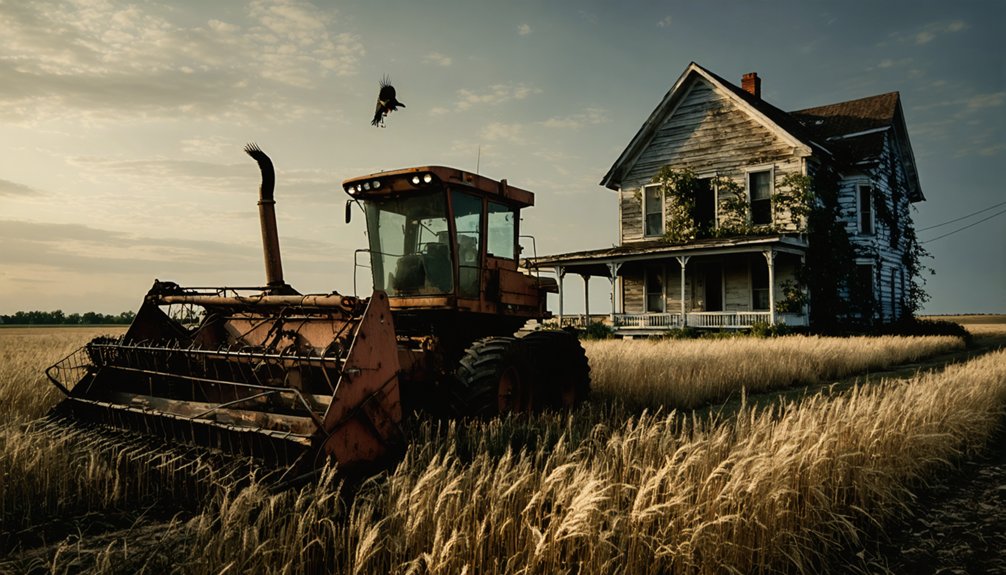
Massive tracts of America’s once-productive farmland now lie dormant, slowly returning to their wild state as nature reclaims what humans have abandoned.
You’ll find over 30 million acres of former cropland scattered across the Great Plains and Mississippi Valley, where economic pressures and water scarcity forced families to leave their livelihoods behind.
As you travel these forgotten landscapes, you’re witnessing one of America’s largest unplanned rewilding strategies.
Fields that once grew wheat now nurture native grasses and wildflowers. Shrublands emerge where tractors once tilled.
Nature reclaims with quiet persistence, painting abandoned farmland with the brushstrokes of its original design.
Former pastures transform into young forests and wetlands, creating havens for wildlife that hadn’t been seen for generations.
This accidental ecological restoration offers a glimpse of what these lands once were—before the plow—and perhaps what they’re meant to become again.
Corporate Consolidation and the Vanishing Family Farm
While family farms have long represented the backbone of American agriculture, a seismic shift has reshaped rural America over the past four decades.
You’re witnessing the paradox of modern farming: 97% of farms remain family operated farms, yet 20% of operations control nearly 70% of all farmland. The American agricultural landscape is transforming before your eyes.
Three stark realities of this consolidation:
- Large farms now operate 41% of all cropland, up from 36% in just five years.
- Non-family corporate farms increased their footprint by 43% between 2017-2022.
- Farms earning over $1 million grew by 36%, while small operations declined by 13%.
As you drive through once-thriving rural communities, the empty farmhouses tell a story of autonomy lost to efficiency, where fewer farmers work more land.
Photographing America’s Agricultural Ruins

You’ll find rusted tractors and discarded implements forming accidental sculptures across America’s forgotten farmlands, their silhouettes standing like sentinels against time.
Through collapsed roofs and weathered walls, golden shafts of afternoon light illuminate dust particles dancing above abandoned dining tables where families once gathered to celebrate harvests.
These silent fields, where nothing grows but wildflowers and memories, await a resurrection that may never come, their stories preserved only through the patient lens of documentary photographers.
Rustic Equipment Graveyards
Across America’s heartland, rusting hulks of tractors and combines punctuate the rural landscape like mechanical tombstones, telling silent stories of agricultural dreams deferred.
These rusty relics stand as physical evidence of mechanization myths that promised prosperity but often delivered debt and disillusionment.
You’ll find these equipment graveyards everywhere, silent witnesses to failed agricultural initiatives:
- Abandoned machinery rots in fields where government programs donated equipment without providing maintenance infrastructure.
- Roadside collections of iron carcasses mark where small farmers couldn’t access financing for repairs.
- Community storage lots filled with broken implements that only “connected” farmers could access.
When you travel rural America, these tractor graveyards reveal the complicated truth about agricultural development—not just progress, but a landscape of discarded dreams and forgotten promises.
Light Patterns Through Decay
In abandoned farmhouses across rural America, photographers find a haunting canvas where light becomes both subject and storyteller. You’ll discover how morning sun streaming through collapsed roofs creates golden shafts illuminating forgotten corners, each ray revealing nostalgic imagery of rural life suspended in time.
When capturing these moments, you’ll need patience and technical skill. Wide-angle lenses embrace the emptiness while tripods steady your camera in dim interiors. The light symbolism isn’t accidental—these transient beams mirror the impermanence of the structures themselves, making your photographs both artistic expression and essential documentation.
On overcast days, diffused light reveals subtle textures of peeling wallpaper and weathered wood. Through your lens, you’re preserving more than beauty in decay; you’re archiving America’s agricultural heritage before these silent witnesses disappear forever.
Silent Fields Await Resurrection
As golden light washes over abandoned tractors and collapsing barns, America’s agricultural ruins tell stories that statistics alone can’t convey.
You’re witnessing our forgotten heritage dissolve into the landscape—1.88 million farms now represent the lowest count in over a century, with 20.1 million acres lost since 2017.
When you photograph these silent fields awaiting resurrection, remember:
- Dawn and dusk reveal the most haunting beauty, casting long shadows across machinery that once sustained generations.
- Document both the structures and surrounding landscapes to capture the full context of rural depopulation.
- Respect property boundaries and local communities still fighting against the tide of agricultural decline.
Your lens preserves what policy discussions often miss—the soul of rural America suspended between memory and an uncertain future.
New Life for Abandoned Land: Renewable Energy Frontiers
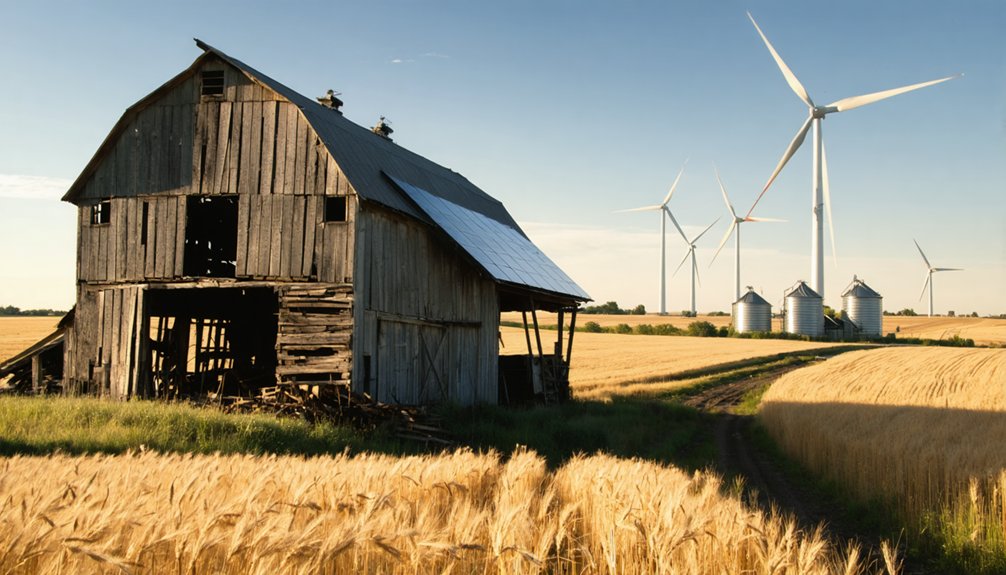
While ghost towns and crumbling barns tell stories of agricultural decline, abandoned farmland and contaminated sites across America are finding remarkable second lives as renewable energy hubs.
You’re witnessing history’s cycle of renewal as New Jersey transforms over 800 former landfills into solar farm repurposing projects, including North America’s largest at Mount Olive.
These forgotten places—neither prime cropland nor pristine wilderness—offer perfect canvases for reinvention.
In-between lands—abandoned relics of America’s past—await their transformation into beacons of renewable possibility.
UW-Madison researchers have mapped 30 million acres of abandoned farmland since the 1980s, land that could generate clean energy while storing carbon.
Through agrivoltaics integration, you can maintain farming traditions beneath solar arrays.
This dual-purpose approach honors agricultural heritage while embracing energy independence.
These innovative strategies transform yesterday’s desolation into tomorrow’s power source—turning abandonment into opportunity.
Frequently Asked Questions
Can Abandoned Farmland Be Reclaimed for Traditional Agriculture?
Yes, you can reclaim abandoned farmland through focused land restoration efforts and sustainable practices. Your forefathers worked these same soils—with determination, those sleeping fields can yield again.
What Psychological Impacts Do Farm Closures Have on Remaining Residents?
You’ll witness deteriorating mental health when neighbors vanish—crushing isolation gnaws at your soul. Your community identity weakens as familiar faces disappear, leaving ghostly reminders of what once bound y’all together.
How Do Abandoned Farm Communities Affect Wildlife Populations?
You’ll find abandoned farmlands becoming wildlife corridors as nature reclaims what’s hers. Native critters return during habitat restoration, though full recovery’s rare. It’s freedom restored to the land, if only temporarily.
What Happens to Farm Equipment Left Behind?
You’ll find those rusting relics of farm equipment slowly returning to the earth—leaking fluids into soil, becoming wildlife shelters, scavenged for parts, or standing as silent monuments to freedom lost.
Are There Government Programs to Preserve Historic Abandoned Farm Structures?
You won’t find much federal government funding through USDA conservation programs, but your state historic preservation office might offer grants to save those weathered old barns of your rural heritage.
References
- https://www.farmprogress.com/farm-policy/u-s-lost-142-000-farms-according-to-ag-census
- https://www.jsonline.com/story/news/2024/06/21/uw-study-mapped-abandoned-farmland-it-could-hold-clean-energy-answer/73958272007/
- https://www.technologynetworks.com/applied-sciences/news/new-us-map-shows-the-abandoned-farms-that-could-help-fight-climate-change-387249
- https://ci.uky.edu/irj/rural-blog/new-tool-finds-abandoned-farmland-could-be-used-fight-climate-change-30-million
- https://www.thepublicdiscourse.com/2021/03/75087/
- https://news.wisc.edu/abandoned-farmlands-could-play-a-role-in-fighting-climate-change-a-new-study-shows-exactly-where-they-are/
- https://agamerica.com/blog/family-farms/
- https://time.com/5736789/small-american-farmers-debt-crisis-extinction/
- https://blogs.loc.gov/maps/2023/12/climate-migrants-of-the-1930s-dust-bowl/
- https://nebraskapublicmedia.org/news/news-articles/a-forgotten-piece-of-african-american-history-on-the-great-plains/
